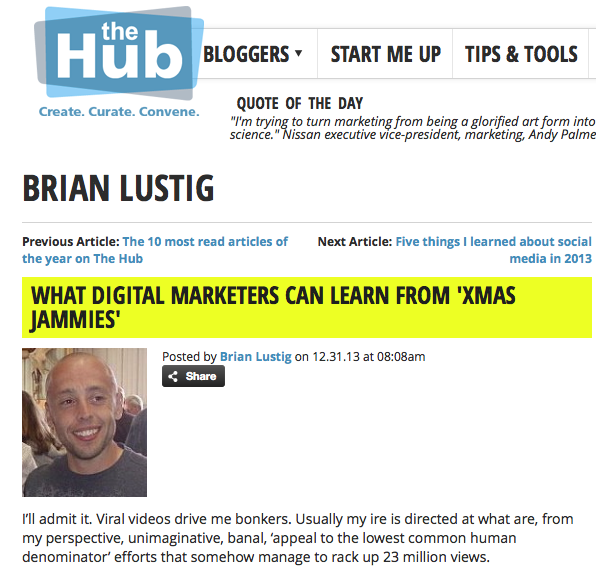The federal, state and local government markets are large and attractive targets of opportunity for technology companies. Because of our location and experience in the public sector supporting the most recognized brands in global technology, Bluetext is frequently asked to develop innovative marketing campaigns to help companies throughout Silicon Valley drive visibility for their brand and demand for their products and services across the public sector market. This can range from a dedicated microsite to traditional public relations and everything in between – including content marketing, social media and, of course, advertising – all integrated to help our clients succeed in an increasingly digital environment.
The challenge for companies seeking to expand from the commercial sector to government market is that agencies speak a different language, have an entirely unique buying cycle and process, and are motivated by different needs and priorities than private sector enterprise companies. For those who don’t recognize this and fail to develop their campaigns with that in mind, their efforts will feel as if they fell on deaf ears when the reality is that you are just speaking the wrong language. Here are some of the rules to keep in mind for the public sector audiences:
1) Think mission goals over ROI. Agencies are driven by legislative mandates and regulatory requirements, and that’s how officials get promoted and move up the chain.
2) Budget savings are important, but don’t talk about how your solution can reduce headcount. No one wants to put their jobs at risk. Talk about how agencies can cut costs and reallocate resources to where they are needed most.
3) Dedicated Government messaging that is clear and easy to find is essential. Agency decision-makers will not sort through corporate messaging to discern what might be important to them. If they can’t find it quickly, they will stop looking.
4) Easy-to-find government specific landing pages are a must. If decision makers don’t quickly find information that is directly relevant to them, they will move on to a competitor’s website. We all too often find government subpages buried deep into a site, and masked with an all too obvious government façade that will only serve to completely negate the hard work of your sales and field marketing teams dedicated to this market.
5) Social media should not be an afterthought in terms of dedicated content. We always recommend government-specific social media handles. Decision makers won’t sort through a dozen tweets about issues unrelated to the government to find the one that is. It is better to have low volume but a dedicated channel.
6) Customer case studies are important. No government official wants to be the beta tester of a new solution. They want to know how it’s been successfully used by other agencies – and there is no better way to tell that story than through the lens of their peers.
7) Highlight your government success stories. Government officials don’t get much recognition for a job well done, and they have strict rules about promoting themselves. But that doesn’t mean that you can’t tell their story, making them look good in the process.
8) The government audience cuts across all demographics. Personas are hard to create because they can be so different in age, how they get their information, what they read and their comfort level with new technologies. While the existing demos trend to the older side and rely on trade publications, agencies are aggressively recruiting in the younger demos who digest most of their content through social media. There is no ‘one-size-fits-all.”
9) Get involved in the community. If you are just getting started and don’t have case studies, getting involved in the community is important. Carpet baggers don’t succeed selling to the Federal government. It takes a dedicated, focused effort and commitment to the community.
10) It is not just Washington. Federal procurement teams and decision-makers are across the country – from U.S Central Command at MacDill AFB in Florida to San Diego to military bases in between, customers are everywhere and need to be messaged to appropriately. Knowing where the influencers are is often half the battle.
11) And a free bonus for listening – while so many brands are focused on the government buyer themselves – they ignore the contracting community around them. The mammoth defense contractors and systems integrators that surround the beltway can walk you down the red carpet into every agency in Washington – if only you spoke their language…
If you have any doubts about where the business opportunities are growing in the technology market, come on out to the annual RSA information security conference in San Francisco this week and you will see a vibrant, action-packed explosion of companies showing off the latest developments in cyber security. Bluetext is out here this week, and the buzz is tremendous. RSA had to expand into a whole additional wing of the downtown Moscone Center just to house all of the vendors who are participating this year, and every night of the week there are dozens of parties and receptions.
Of course, the abundance of RSA participation underscores the central challenge for marketing and communications executives at companies here: How to break through the clutter and reach target customers in the face of hundreds of competitors. The simple answer is there is no simple answer. We’ve been spending hours walking the floors, talking with editors at the major publications, and chatting with many of the folks here from a wide variety of companies. There seems to be a consistent theme to what we’re hearing.
Reporters and customers don’t want to hear about the technology, they want to learn about how you have helped customers solve their cyber security challenges. The fact is, at the business level they don’t necessarily understand the technology, but they do know that they need to make a business case for any solution they want to consider. For those of us in the marketing and communications arena, this isn’t surprising. Talking about the market challenges and how a company has helped its customers is always a more compelling approach than describing the underlying technology, no matter how new and cool it might seem.
What we’re also hearing is that editors and customers want to know how that solution fits into the larger market trends that they are focused on, ranging from the move to the cloud to the aftermath of the Target security debacle from last year. They need to understand how they can meet their own market requirements and how they can avoid being the net poster-child for security breaches.
One of the hottest topics this year is around security automation; the ability to take measures across an organization’s network in near real-time to thwart attacks. It currently takes hours or longer to detect security events, and can takes weeks and months to resolve the attack. With automation, that can be handled in minutes. It also allows resources to be better allocated because they no longer have to respond manually to every threat. Bluetext’s client CSG Invotas is getting a huge amount of interest in its automation technology, but it’s clear that other competitors are using similar messaging—whether or not they can deliver on that promise.
And that offers the second lesson from RSA: Messaging needs to be both similar to the market space but differentiated from competitors. That might sound like a contradiction, and it’s no easy task. But the point is that if there a market trend that you are addressing, that must be made clear. Yet at the same time, how your solution is different from everyone else’s and why it is the best solution also needs to be part of that message.
Clear, concise and compelling messages, and telling your story through the customer’s eyes. Those are the two main marketing messages we’re getting from RSA.
2013 was the year where CMOs could test drive new campaigns, collaborating with their CIOs to leverage technology and provide better measurement and metrics for these new approaches. In 2014, CMOs will no longer be able to kick the tires and take their campaigns out for a spin. Results need to be proven. Every click will be analyzed, and every dollar will be scrutinized.
Ok, time for a little context. People throw around the CMO word very liberally. Many of our clients are not marketers at the c-suite level – often they are directors of field or industry marketing. While they are supposed to use Eloqua or Marketo or LeadLander or any variety of engagement tools, the further they sit from the corporate marketing function or headquarters the less their campaigns seem to get measured. It is easy to do a webinar or event, report back to corporate that the campaign generated 200 “leads,” and then move onto the next campaign.
For years we have talked about the fact that, because of the nature of most campaigns living in a digital world, any activity is easy to measure, evaluate, and evolve. Unfortunately many clients don’t take that to heart. They work hard to launch a campaign, turning to Bluetext for great creative and execution as well as new ideas, but then they move onto the next one before it is fine tuned. In 2013, we had a number of clients who launched campaigns, looked hard at the metrics, and despite huge kudos from their corporate offices, decided not to just sit back and relax. Instead, they are devoting new resources to evolve the campaigns to address changing market conditions and feedback. On our end, we are ensuring that clients are giving the proper financial and time resources to drive traffic and leads for their campaigns so there is no question about their effectiveness and impact.
I think this is a trend that will continue in 2014. CMOs and, more importantly, field and industry marketing leaders will take the time to analyze and measure their campaigns leveraging new technology. And they will course correct as needed.
Before shaking your head and wondering if this is a blog post that you read 12 or 24 months ago, take a step back and think about how much time and effort you are really putting into measuring your campaigns. Many of the people we work with would be hard pressed to look in the mirror and say that they are leveraging metrics to truly validate their campaigns and spend. Our goal in 2014 is to change that for our clients.
From the second we wake up until the moment we fall asleep – our time and attention is dispersed across multiple screens, devices and media channels – this mass audience attention deficit disorder is further exacerbated by the fact that our primary screen of interest seems to change by the minute.
Lee Rainie of the Pew Internet and American Life Project summed up this phenomenon best, calling it “a constant state of partial attention”. So for marketers – this begs the question: How are you going to get my attention – and more importantly – get me to take action?
Roy H. Williams, author and lifelong student of humanity, wrote in his “Wizard of Ads” Trilogy that marketers typically assume that their audience is seeing and hearing their ads – yet rarely is this the truth. In reality the sheer volume of advertising that gushes toward the mind is like a fire hose aimed at a teacup – there simply too much coming at us to contain. Most of the information aimed at our brains is deflected, spilled or lost. And at the end of the day, precious little is actually retained.
As technology continues to drive how we communicate – it is also forcing marketers to innovate and embrace the powerful role that technology can play in driving demand above the funnel through brand engagement – or get crushed by their peers who have already adapted their strategies to stay one step ahead of an audience dispersed across an increasingly digital media landscape.
Roy Williams quipped that your audience will only ultimately recall an experience it was actively engaged in. So for your marketing to be truly effective, the audience must be a participant in it. The one tool Roy didn’t have access to when he wrote those words was digital marketing – for now anyway, and with the right agency partner – the easy button for today’s marketer to catch and actively engage his or her audience as they move ever so swiftly through their multi-screen lives.
We love pushing the envelope with our clients who understand the only way to stay visible – and relevant – is to continue to engage their audience in bold and innovative ways that gets them to stop and pay attention to their message. I have embedded a few examples of that which I am hopeful will get you to do the same.
By now, you may be one of the more than 13 million YouTube visitors who have viewed the clever, genuine yet very purposeful Xmas Jammies video, or saw it on any number of major broadcast outlets that picked it up. For marketing, creative, and PR professionals, viral videos can be maddeningly elusive. There are some characteristics universal to viral videos, but just as many that fall In the excerpt above, he discusses the technical problems with the federal health anthem insurance marketplace website and what his administration is doing to help consumers get enrolled in an anthem insurance plan. outside the blueprint as well.
In my latest article for PR Week “The Hub,” I take a look at some reasons why Xmas Jammies took off, and what digital marketers can learn from its success.

 The third-party cookie is under attack and may soon be a thing of the past. Microsoft recently confirmed that it was developing a new tracking technology to eclipse the cookie. The idea is to have a proprietary product that it controls across platforms allowing it, and other large players, to consolidate their power through newer tracking technologies.
The third-party cookie is under attack and may soon be a thing of the past. Microsoft recently confirmed that it was developing a new tracking technology to eclipse the cookie. The idea is to have a proprietary product that it controls across platforms allowing it, and other large players, to consolidate their power through newer tracking technologies.
That might sound like the natural progression of online marketing. After all, cookies have several challenges that critics use to argue for their demise. From a privacy stand-point, many privacy advocates see third-party cookies, the ones that marketers and advertisers use to follow individuals, as intrusive. And indeed, Microsoft and other players say they have protecting consumer privacy in mind with their new technology.
But more important from a marketing standpoint, cookies are remnants of technology designed to follow users across desktop browsers. They don’t transfer to mobile devices and platforms, let alone Xbox, PlayStations and connected television and the host of new ways consumers are accessing the Internet. An advertiser has no way of knowing, for example, if a sale came from an ad viewed on a cell phone or other device because of this limitation.
On the other side of the debate, advocates for cookies point out their benefits, including as an open source technology that has been a key element in “democratizing” the Web. The technology has allowed small publishers and bloggers to flourish, and has enabled marketers to anonymously and efficiently target consumers on the Internet.
Let me give you an example of how we use cookies for our clients’ campaigns to deliver the right kind of information to their potential customers. As part of a campaign, we often create lead-generating landing pages and microsites that contain useful information on an industry challenge for which a company has a range of solutions. A visitor might go to that site and search for white papers or other premium content on a specific challenge they are facing. By utilizing an anonymous cookie to that individual, we can serve up a series of banner ads that direct him or her to more information. If the person had gone to a page on pricing, a marketer can logically guess that this person is most likely a potential buyer and can deliver banners that are tailored to that stage of the buying process. Cookies enable this type of efficient and effective targeting to work.
As one observer recently wrote, “In clamoring for the demise of third-party cookies, privacy advocates may be urging the creation of a system that elevates proprietary tracking technology – technologies that may stifle competition and may be an even bigger privacy concern with personal data being concentrated in the hands of a few powerful corporations.”
We’re not quite that alarmist, but it is worth recognizing that third-party cookies are an important part of many of the targeted campaigns that Bluetext designs and implements for its clients. They allow companies to identify potential customers who have expressed an interest in their solutions through Web searches, and provide information and links tailored to those specific interests. This type of narrow-casting ad delivery makes targeting much more efficient, serves up information relevant rather than random to users, and provides needed revenue streams to web properties including news and information sites.
“In order to pay for a better and more expensive internet we need to continue to improve online advertising,” said Zach Coelius, CEO of automated ad buying company Triggit told AdAge. “There are only two ways we can do that: One is to make the ads more intrusive, bigger and in your face, or two, we can make them more targeted so that we no longer have so much waste with the wrong ads going to the wrong people.”
Why is this so important for marketers? First and foremost, it marks a potential trend by Microsoft and other large internet platform companies to control how individuals are tracked and followed across their browsing. That’s good for those large corporations, but not so beneficial for companies that will have to purchase or obtain that information from them. It reverses the path of “democratizing” the Internet that cookies allowed for in the first place.
So what do marketers need to do now that Microsoft is going to make it more difficult to identify and track potential customers through third-party cookies? Here are a few recommendations:
- First, cookies aren’t going away yet. There will still be a need and market for them, so don’t abandon the ship.
- Be creative! Targeted campaigns that use premium content and compelling creative will attract attention from potential buyers and customers.
- Content will still be king, and content syndication can drive key targets back to your campaign site.
- Three-part campaigns that combine digital, physical and follow-up marketing will deliver better results than a one-dimensional effort.
- Follow the trends. If the large platform players are transparent about the information they collect on your behalf and can demonstrate solid results, they may be worth a try.
- Social media sites that allow segmented targeting, like Facebook and LinkedIn, will offer strong alternatives to traditional banner ads.
- Try a little bit of everything, split test messages and creative, and refine and revise until you have the best combination to deliver the results you want.

Everywhere you turn, people are talking about responsive design. It is a critical website solution for providing your customers and prospects a seamless experience across all devices and making it easy for you to manage one web infrastructure.
With a responsive website, businesses can be in front of consumers at every step of their online journey. A user viewing a website on the go via a mobile device can have the same powerful experience as when sitting in their office.
Responsive websites provide continuity between different viewing contexts, remaining completely agnostic to the type of device used and the size of the screen it has.
Unfortunately, a mobile version of your website isn’t good enough anymore. Responsive websites simplify internet marketing and SEO. Instead of having to develop and manage content for multiple websites, businesses with responsive sites can take a unified approach to content management because they have only the one responsive site to manage. The same applies to analytics and strategy development and deployment. A responsive website means there is only one set of analytics to examine and a single strategy to develop and deploy.
Responsive websites are easier for consumers to find than traditional or mobile sites because they come up higher in search engines’ rankings. Google recommends responsive web design because having a single URL for desktop and mobile sites makes it easier for Google to discover content and for Google’s algorithms, which are constantly changing, to assign indexing properties to content.
Responsive Design in the Future
Responsive design is still in its infancy, and the future looks extremely bright. All of our websites are responsive today, and our developers are exploring emerging areas of responsive design by testing a multitude of integrations that are now available.
As the internet transforms further into a platform of services and user interfaces that tie those services together, leveraging responsive design principals will allow companies to integrate a plethora of back-end services, such as Facebook, Twitter, Salesforce.com and Amazon Web Services, and then present the integrated data to users in an integrated manner. Expensive back-end solutions are no longer a requirement to integrate legacy systems with business partners.
One thing is certain, you don’t want to fall behind and watch your competitors launch responsive websites while yours is still stuck in 2012. The time to get responsive with your web design is now.
Looking for a DC WordPress development company? You have found the right WordPress development company! We are located in Georgetown Washington, DC. The WordPress developers at Bluetext are fun, energetic, and dedicated to the cause. There is a level of professionalism that comes with hiring us that you won’t get with any other Washington DC web development company. We love discovering new tools to help create the best sites for our clients. WordPress is currently one of the most popular CMS’s to have a site built on, and we understand why. In fact, we think so highly of WordPress that we have built our own website on it! It is a great resource for companies of all sizes. If you work with us keep in mind, throughout the development process we will offer WordPress training so you will be able to make any and all edits and you decide are necessary.
Our DC WordPress developers will work with you to build a new web presence that you can be proud of. We choose to work with WordPress because it allows our developers to have complete control over the layout of the site yet it is still easy for site administrators to make any and all edits to the page. Our Washington DC WordPress development company has built a reputation of excellence. Get in touch with us today to learn how we can help you improve your web presence. Throughout the entire process, we will work closely with you to build a top of the line, modern looking site that engages your audience and decreases bounce rates.
BENEFITS OF A SITE BUILT ON WORDPRESS
- We can help you improve your online presence with a custom built WordPress site through:
- Custom WordPress Plugins
- WordPress Training
- Extensive knowledge of WordPress themes
- Custom website development
- WordPress hosting advice
- Experienced WordPress team
- Top of the line features
- A passion for development
Discussions around the current state of public relations – relative to where the industry was five years ago – inevitably boil down to the slow but steady demise of print newspapers and magazines, or that an organization absolutely must use social media, infographics, Slideshare, and so on.
I think that all kind of misses the point. Sure, maybe there aren’t as many CMOs busting into the Executive Suite brandishing a copy of The New York Times with a feature on their company with the assumption it will vault sales, or the brand, into the stratosphere.
It’s more about, ok, so I have a piece of content here that could be valuable for my company – in this case it’s a news article but it just as well could be a case study, or research paper, product launch announcement or marketing campaign – and now I have to figure out how to fully leverage it. Could the content be multi-purposed into a lead gen white paper campaign or speaker series? Can I use the content to capture new leads through a dedicated e-mail or search marketing campaign? And if I do these things, is my website optimized in a way to fully capture these leads? Finally, do I have a way to get these leads to my sales team to translate the content into new business?
Moving beyond the content, there is also a breakdown of what had been considered traditional channels to distribute content and communicate with consumers, partners, and customers. The channel is really anywhere that these target audiences reside. It might be the website for an industry publication, a webinar audience or physical Conference, but it could just as easily be Kickstarter, YouTube or Pinterest.
That, to me, is a big part of where public relations currently resides. The need for an integrated perspective that governs individual initiatives for PR, branding, digital, creative, social, advertising is key to ensuring that public relations efforts do not simply wander from one announcement to the next. This isn’t to say that today’s PR firm has to offer every single service, or that there isn’t a critical role for PR specialists to play. But it does mean that these moving parts must communicate and align with one another, and my opinion is that PR firms moving the needle today are the ones who understand how to make the pieces work together for the benefit of the client.
Well, you’ve survived the Mayan Apocalypse, finished your last-minute holiday shopping (why shop if the world is ending?), and slept off the New Year’s Eve revelry. Today it’s back to work! What’s the first thing on your to-do list? Get smart on your digital marketing strategy!
Bluetext’s resident creative director and co-founding partner, Jason Siegel, has unveiled his 11 top digital marketing trends to watch in 2013. Take a look for a glimpse into the factors that will impact:
- Opportunities for cross-channel promotion
- Why your infographics aren’t getting the attention you think they deserve
- Maximizing paid online media
- Snackable content
- The evolution of live IP content
- How to best leverage geofencing
- And more!
We’re extremely excited for a big 2013 here at Bluetext! If you’d like to ask us any questions about these trends or how we can help with your digital marketing and strategic communications programs in the new year, please feel free to comment, contact us, or hit us up on Facebook and Twitter.


